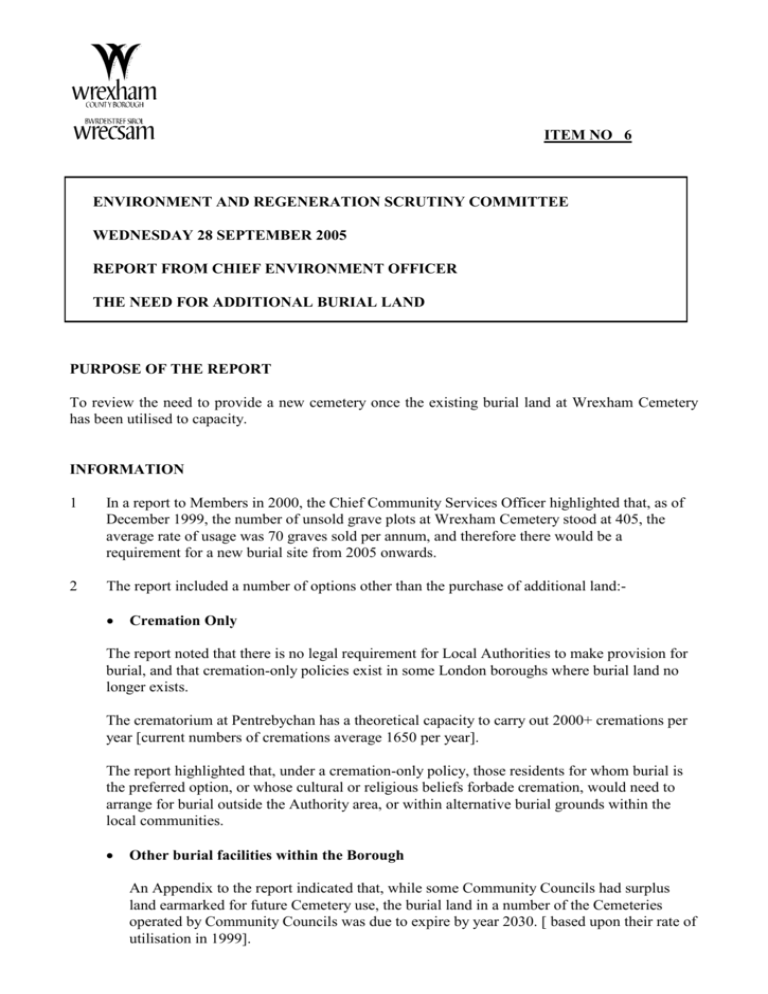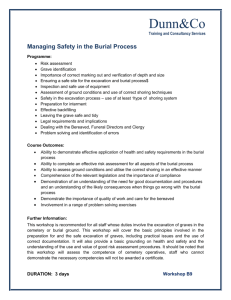Copy herewith - Wrexham County Borough Council
advertisement

ITEM NO 6 ENVIRONMENT AND REGENERATION SCRUTINY COMMITTEE WEDNESDAY 28 SEPTEMBER 2005 REPORT FROM CHIEF ENVIRONMENT OFFICER THE NEED FOR ADDITIONAL BURIAL LAND PURPOSE OF THE REPORT To review the need to provide a new cemetery once the existing burial land at Wrexham Cemetery has been utilised to capacity. INFORMATION 1 In a report to Members in 2000, the Chief Community Services Officer highlighted that, as of December 1999, the number of unsold grave plots at Wrexham Cemetery stood at 405, the average rate of usage was 70 graves sold per annum, and therefore there would be a requirement for a new burial site from 2005 onwards. 2 The report included a number of options other than the purchase of additional land: Cremation Only The report noted that there is no legal requirement for Local Authorities to make provision for burial, and that cremation-only policies exist in some London boroughs where burial land no longer exists. The crematorium at Pentrebychan has a theoretical capacity to carry out 2000+ cremations per year [current numbers of cremations average 1650 per year]. The report highlighted that, under a cremation-only policy, those residents for whom burial is the preferred option, or whose cultural or religious beliefs forbade cremation, would need to arrange for burial outside the Authority area, or within alternative burial grounds within the local communities. Other burial facilities within the Borough An Appendix to the report indicated that, while some Community Councils had surplus land earmarked for future Cemetery use, the burial land in a number of the Cemeteries operated by Community Councils was due to expire by year 2030. [ based upon their rate of utilisation in 1999]. 2 The report highlighted that, in the event that additional land was not provided by the County Borough, there would be a consequential increased in the utilisation of land at community cemeteries which would result in a reduced lifespan for those cemeteries effected. Community Cemeteries may not be easily accessible to those living outside the immediate community area, and, in addition, it is common practice for Community Councils to charge an additional premium on the normal fees & charges to those not residing within the community area. Re-use of existing graves The report highlighted national efforts to persuade the government to allow Councils to reuse those existing graves to which the Exclusive Rights of Burial had expired, but which potentially had burial space remaining within the grave. The procedure would involve the removal of the existing remains of the deceased, re-interring the remains at a greater depth, and re-using the space created for new graves. The report noted that the introduction of a policy allowing the re-use of older graves would require a significant change in attitude towards the permanence of burial by the British public who, since Victorian times, have come to believe that grave use is in perpetuity. Although the case for Re-Use was included in the Home Office document “Burial Law and Policy in the 21st Century” [January 2004], no decision has been made by the government to-date, and consequently, such practice is not yet permitted by the Home Secretary. UPDATE OF 1999 ASSESSMENT 3 National statistics relating to the disposal of the dead continue to indicate an ongoing demand for burial. During 2004 the ratio of disposals by cremation compared to burial stood at 72% cremations to 28% burials. The majority of families wish to purchase a grave plot which will accommodate two or more burials (i.e. two parents + one offspring) 4 The current provision [as at 1 July 2005] for new graves at Wrexham Cemetery stands at 133 graves for up to three bodies. A further 28 grave plots are available for single interment only, due to the presence of a localised high water table in one location. The number of new graves sold during 2004, including those pre-purchased in reserve, was 64. 5 Assuming a continuation of the above rate of utilisation, there will be a need for new grave plots to accommodate up to three burials for adult burials from July 2007 onwards. 6 Wrexham Cemetery will continue to provide facilities for the burial of infants for a further 4½ years [ to mid 2008], and for the purchase of cremated remains plots for a further 6 years [2010]. LEAD-IN TIME FOR DEVELOPMENT OF A NEW CEMETERY 7 Ideally, we would wish to have a full 12 months before opening a new cemetery in which to construct the infrastructure e.g. drainage, buildings, roads, landscaping, etc. That is, we would wish to start work early in 2006, once ground conditions permit. Obviously, not all of the cemetery needs to be landscaped prior to opening, and temporary office and staff 3 accommodation could be provided in the first instance, but it is more economic to carry out major works such as drainage and road works in a single phase. It follows therefore that we would ideally need to have member consultations, all designs in place, and planning permissions approved, by the end of winter 2005/06. 8 The above timetable is being overtaken by the need to fulfil stringent requirements from the Environment Agency, prior to completing ongoing negotiations to acquire the preferred site. However, the general requirement for a minimum 12 months lead-in period, prior to opening, remains the same. In order to open a new site for burial by July 2007 we would ideally need to be in a position to commence structural landscape works by early spring 2006. BACKGROUND PAPERS None WEBSITE INFORMATION None Report Ref: CEnO/08/05S



